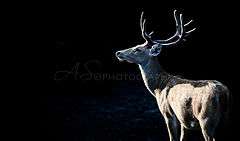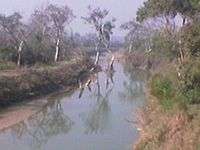Dudhwa National Park
| Dudhwa National Park | |
|---|---|
| Dudhwa Tiger Reserve | |
|
IUCN category II (national park) | |
 | |
| Location | Lakhimpur Kheri, Uttar Pradesh, India |
| Nearest city |
Palia Kalan 9 kilometres (5.6 mi) E |
| Coordinates | 28°30.5′N 80°40.8′E / 28.5083°N 80.6800°ECoordinates: 28°30.5′N 80°40.8′E / 28.5083°N 80.6800°E |
| Area | 490.3 |
| Established | 1977 |
| http://uptourism.gov.in/pages/top/explore/top-explore-dudhwa-national-park | |
The Dudhwa National Park is a national park in the Terai of Uttar Pradesh, India, and covers an area of 490.3 km2 (189.3 sq mi), with a buffer zone of 190 km2 (73 sq mi). It is part of the Dudhwa Tiger Reserve.[1] It is located on the Indo-Nepal border in the Lakhimpur Kheri District, and has buffer of reserved forest areas on the northern and southern sides. It represents one of the few remaining examples of a highly diverse and productive Terai ecosystem, supporting a large number of endangered species, obligate species of tall wet grasslands and species of restricted distribution.[2]
History
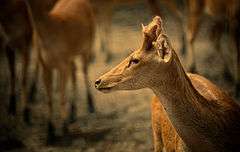
The area was established in 1958 as a wildlife sanctuary for swamp deer. Thanks to the efforts of Billy Arjan Singh the area was notified as a national park in January 1977.[2] In 1987, the park was declared a tiger reserve and brought under the purview of the ‘Project Tiger’. Together with the Kishanpur Wildlife Sanctuary and the Katarniaghat Wildlife Sanctuary it forms the Dudhwa Tiger Reserve.[1]
Climate
Like most of northern India, Dudhwa has an extreme Humid Subtropical with dry winter (CWa) type of climate. Summers are hot with temperatures rising up to 40 °C (104 °F). During winters from mid-October to mid-March, temperatures hover between 20 and 30 °C (68 and 86 °F). The months of February to April are ideal for visiting the park.
Prevalent winds are westerly. The hot wind Loo blows strongly from mid-April up to end of May. Monsoon starting in mid-June and lasting up to September accounts for 90% of the rainfall of 150 cm (59 in). Temperatures range from between a minimum of9 °C (48 °F) in winter to a maximum of up to 45 °C (113 °F) in peak summer.[2]
Habitat
The area of the park falls within the Upper Gangetic plains and is a vast alluvial plain ranging in altitude from 150 m (490 ft) in the farthest southeast to 182 metres (597 ft) in the extreme north. The park's mosaic of high forest interspersed with grasslands is characteristic of the Terai ecosystems in India and the area is, probably, the last prominent remnant of this type of ecosystem. The forests, especially the sal forests, have always been very dense and can be categorized into northern tropical semi-evergreen forest, northern Indian moist deciduous forest, tropical seasonal swamp forest and northern tropical dry deciduous forest. The main flora comprises sal, asna, shisham, jamun, gular, sehore and bahera. The grasslands comprise about 19% of the park. The wetlands constitute the third major habitat type and include the rivers, streams, lakes and marshes. While many of the major wetlands are perennial with some amount of surface moisture retained round the year, some dry up during hot summer.[2]
The park is home to one of the finest forests in India, some of these trees are more than 150 years old and over 70 ft (21 m) tall.
Fauna
Major attractions of Dudhwa National Park are the tigers (population 98 in 1995) and swamp deer (population over 1,600). Billy Arjan Singh successfully hand-reared and reintroduced zoo-born tigers and leopards into the wilds of Dudhwa. Some rare species inhabit the park. Hispid hare, earlier thought to have become extinct, was rediscovered here in 1984.
In the mid-1980s, Indian rhinoceros was reintroduced into Dudhwa from Assam and Nepal.
The other animals to be seen here include swamp deer, sambar deer, barking deer, spotted deer, hog deer, tiger, Indian rhinoceros, sloth bear, ratel, jackal, civets, jungle cat, fishing cat, leopard cat.
Dudhwa National Park is a stronghold of the barasingha. Around half of the world's barasinghas are present in Dudhwa National Park. Smaller than the sambar deer, the barasinghas have 12 antlers that collectively measure up to 100 cm (39 in). One can spot herd of these rare animals passing through open grasslands. Around half of the surviving population of Barasinghas is found in the park. These animals are smaller than sambar deer and weigh around 180 kg. Due to their slightly woolly, dark brown to pale yellow cloak, the grasslands acts as the perfect camouflage.
Birds
The park has rich bird life, with over 350 species, including the swamp francolin, great slaty woodpecker and Bengal florican. Dudhwa also boasts a range of migratory birds that settle here during winters. It includes among others, painted storks, black and white necked storks, sarus cranes, woodpeckers, barbets, kingfishers, minivets, bee-eaters, bulbuls and varied night birds of prey.
There are also drongos, barbets, cormorants, ducks, geese, hornbills, bulbuls, teal, woodpeckers, heron, bee-eaters, minivets, kingfishers, egrets, orioles, painted storks, owls.
Dudhwa's birds in particular are a delight for any avid bird watcher where bengal florican is most popular between bird watchers. The marshlands are habitat for about 400 species of resident and migratory birds including the swamp francolin, great slaty woodpecker, Bengal florican, plenty of painted stork, sarus crane, several species of owl, Asian barbet, woodpecker and minivets. Much of the park’s avian fauna is aquatic in nature and found around Dudhwa’s lakes such as Banke Tal.
Gallery
-
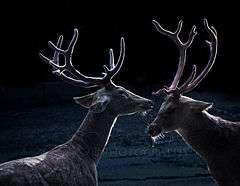
Swamp deer
-
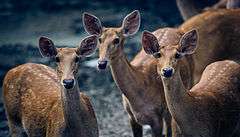
Deer
-

Deer
-

Hog deer at Dudhwa
-
Riverside
-
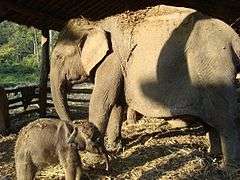
Elephants
-

Elephants
-

Entrance to the park
References
- 1 2 Mathur, P. K. and N. Midha (2008). Mapping of National Parks and Wildlife Sanctuaries, Dudhwa Tiger Reserve. WII – NNRMS - MoEF Project, Final Technical Report. Wildlife Institute of India, Dehradun.
- 1 2 3 4 Kumar, S. (2009). Retrieval of forest parameters from Envisat ASAR data for biomass inventory in Dudhwa National Park, U.P., India. (PDF). Indian Institute of Remote Sensing and International Institute for Geo-information Science and Earth Observation.
External sources
- Dudhwa National Park: the Jurassic park of India
- Flickr: Dudhwa National Park
- DudhwaLive e-Magazine
- Dudhwa National Park: देखो टाइगर जंगल में
- Avibase - Bird Checklists of the World - Dudhwa National Park
- Muhammad Naseem: Wildlife & Birding Guide Expert In Dudhwa
![]() Dudhwa National Park travel guide from Wikivoyage
Dudhwa National Park travel guide from Wikivoyage
